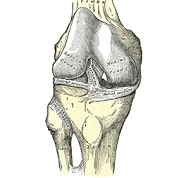The first thing we are going to do, before entering fully into the meaning of the term ligament, is discover its etymological origin. In this case, we have to explain that it derives from Latin, exactly from the word "ligamentum." This is the result of the sum of two lexical components of said language:
-The noun "ligamen", which is used to refer to any instrument used to tie and which, in turn, emanates from the verb "ligare", which can be translated as "to tie" or "to tie".
-The instrumental suffix «-mentum».
According to the first meaning mentioned by the Royal Spanish Academy ( RAE ) in its dictionary, it is the act and result of linking or linking : merging, adhering, uniting.
 The most common use of ligament, however, refers specifically to an anatomical piece . Ligaments are portions of fibrous connective tissue that allow joints and bones to join together.
The most common use of ligament, however, refers specifically to an anatomical piece . Ligaments are portions of fibrous connective tissue that allow joints and bones to join together.
Of great resistance and elasticity, a ligament has a composition similar to a tendon . These bands allow the bone to move, but not excessively. This way they avoid dislocations and other injuries in the event of forced displacement.
Ligaments, in short, have the function of stabilizing and uniting anatomical structures . While tendons are responsible for connecting bones to muscles , ligaments link bones that are adjacent to each other. What they do is facilitate movements that are natural for the anatomy and restrict those that, on the other hand, are abnormal and would cause damage.
In the knee area, for example, we can find four main ligaments that connect the femur, tibia and patella . They are the anterior cruciate ligament , the posterior cruciate ligament , the lateral collateral ligament , and the medial collateral ligament .
Among the most significant ligaments is, for example, the ligament of Treitz, which also responds to the name of the suspensory muscle of the duodenum. It is located in the area of the diaphragm and is named after the Czech anatomopathologist Václav Treitz (1819 – 1879).
Ligaments are generally classified as corded or ribboned . Cordonal or cordonal ligaments go from one bone to another, while ribbon ligaments do not lose contact with the structures .
Among the most frequent pathologies that affect the aforementioned ligaments is the so-called anterior cruciate ligament injury. It is very common among athletes, especially among soccer players and those who play basketball, and consists of a tear or sprain of the ligament that gives it its name and which is located in the knee.
Pain, swelling of the knee and a feeling of instability are three symptoms that indicate that a person has suffered the aforementioned injury. The way to treat it may be with simple rest, performing rehabilitation exercises or having to resort to surgery. Specifically, the operation will consist of replacing the ligament that has been torn.
Beyond the joints, each membranous fold that keeps an organ in its proper position is also called a ligament.
